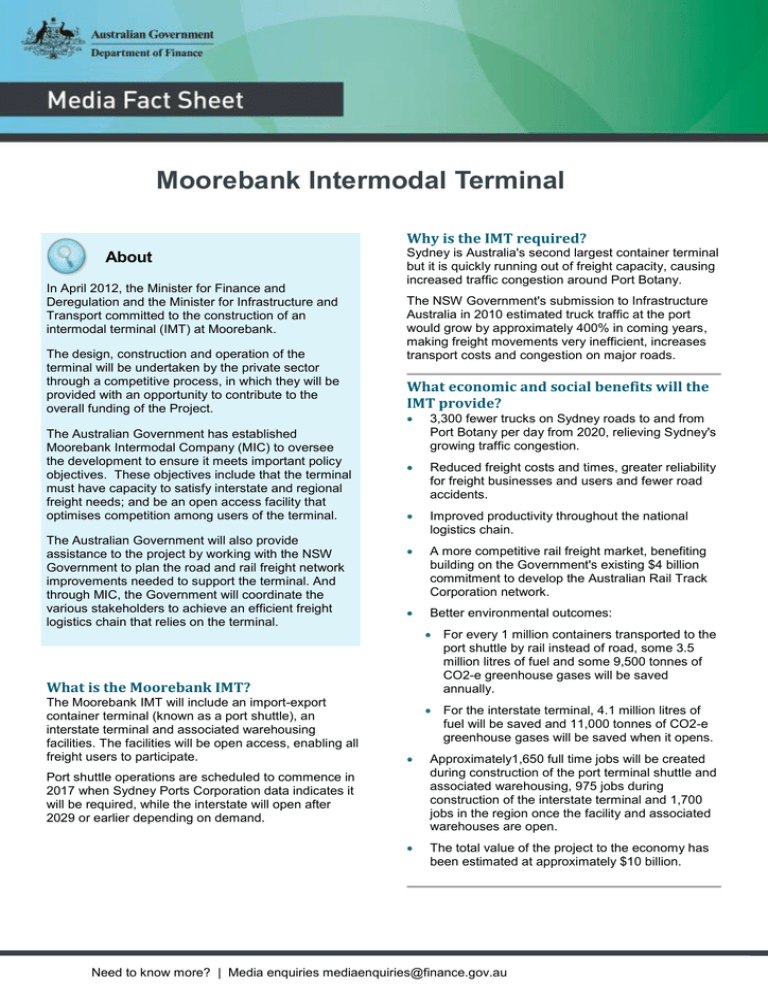Moorebank Intermodal Terminal About Why is the IMT required?
advertisement

Moorebank Intermodal Terminal Why is the IMT required? About In April 2012, the Minister for Finance and Deregulation and the Minister for Infrastructure and Transport committed to the construction of an intermodal terminal (IMT) at Moorebank. The design, construction and operation of the terminal will be undertaken by the private sector through a competitive process, in which they will be provided with an opportunity to contribute to the overall funding of the Project. The Australian Government has established Moorebank Intermodal Company (MIC) to oversee the development to ensure it meets important policy objectives. These objectives include that the terminal must have capacity to satisfy interstate and regional freight needs; and be an open access facility that optimises competition among users of the terminal. The Australian Government will also provide assistance to the project by working with the NSW Government to plan the road and rail freight network improvements needed to support the terminal. And through MIC, the Government will coordinate the various stakeholders to achieve an efficient freight logistics chain that relies on the terminal. Sydney is Australia's second largest container terminal but it is quickly running out of freight capacity, causing increased traffic congestion around Port Botany. The NSW Government's submission to Infrastructure Australia in 2010 estimated truck traffic at the port would grow by approximately 400% in coming years, making freight movements very inefficient, increases transport costs and congestion on major roads. What economic and social benefits will the IMT provide? 3,300 fewer trucks on Sydney roads to and from Port Botany per day from 2020, relieving Sydney's growing traffic congestion. Reduced freight costs and times, greater reliability for freight businesses and users and fewer road accidents. Improved productivity throughout the national logistics chain. A more competitive rail freight market, benefiting building on the Government's existing $4 billion commitment to develop the Australian Rail Track Corporation network. Better environmental outcomes: For every 1 million containers transported to the port shuttle by rail instead of road, some 3.5 million litres of fuel and some 9,500 tonnes of CO2-e greenhouse gases will be saved annually. What is the Moorebank IMT? The Moorebank IMT will include an import-export container terminal (known as a port shuttle), an interstate terminal and associated warehousing facilities. The facilities will be open access, enabling all freight users to participate. For the interstate terminal, 4.1 million litres of fuel will be saved and 11,000 tonnes of CO2-e greenhouse gases will be saved when it opens. Approximately1,650 full time jobs will be created during construction of the port terminal shuttle and associated warehousing, 975 jobs during construction of the interstate terminal and 1,700 jobs in the region once the facility and associated warehouses are open. The total value of the project to the economy has been estimated at approximately $10 billion. Port shuttle operations are scheduled to commence in 2017 when Sydney Ports Corporation data indicates it will be required, while the interstate will open after 2029 or earlier depending on demand. Need to know more? | Media enquiries mediaenquiries@finance.gov.au Why has the Government established a wholly owned Commonwealth GBE to deliver the IMT? Due to the significance of the project and the policy issues involved, the Government established a GBE to deliver the IMT. The GBE will access private sector experience to develop an innovative facility to unlock the full potential of an IMT at Moorebank. On 13 December 2012, the Minister for Finance and Deregulation and the Minister for Infrastructure and Transport announced the establishment of the Moorebank Intermodal Company (to be the GBE) and the appointment of its Board members. The GBE will act as a landlord to ensure that the Government’s policy objectives are achieved for the IMT. The GBE will engage with the private sector and is currently undertaking a competitive tender process for the private sector to design, construct, operate and maintain the terminal, with a view to maximising private sector participation and optimising private funding. Project Timeline Late 2013 - Release of the Request for Expression of Interest – the first phase of the procurement process to design, build and operate an intermodal terminal at Moorebank. Mid 2014 - Shortlisting of proponents from the first stage of the procurement process and the issuing of the Proposal Development Request – the second phase of the procurement process. Late 2014 - Preferred proponent to be selected. Mid - Late 2015 School of Military Engineering vacates the terminal site - Construction of the terminal begins Late 2017 - Port shuttle terminal operations begin Mid 2027 - Interstate construction begins (or earlier depending on demand) Early 2029- Interstate operations begin (or earlier depending on demand) Who has been appointed the Chair and Directors of the GBE? Dr Kerry Schott has been appointed the Chair of the Company, and Ms Claire Filson, the Hon Andrew Fraser, Mr Stephen Williams, Mr Ray Wilson, Mt Paul Binsted, Mr Christopher Brown, Ms Zorana Bull and Ms Louise Thurgood, have been appointed as Directors. Mr Ian Hunt is the Chief Executive Officer. For more information regarding the project please go to the MIC website. Further details about the Chair and Directors can be found on the MIC website. Need to know more? | Media enquiries mediaenquiries@finance.gov.au

